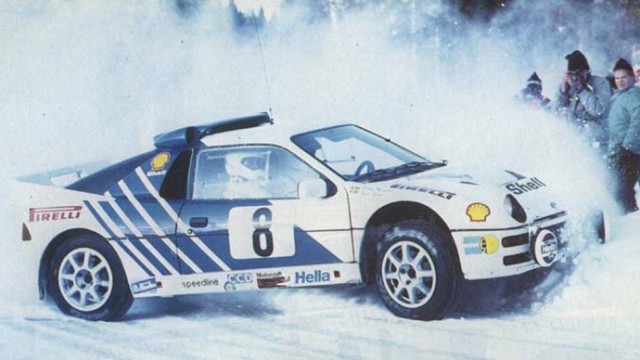Ford RS200 E in the World Rally Championship

Manufacturer:
 Ford
Ford
Category: Group B
The Ford RS200 E was developed by Ford Motorsport in response to the new Group B regulations introduced in the early 1980s. It was designed as a purpose-built rally car to compete in the highly competitive Group B category, which allowed for significant technical freedom and innovation.
The Ford RS200 E's participation in the Group B era of rallying left a lasting legacy in motorsport history. Despite the premature end of Group B regulations in 1986, the RS200 E remains an iconic and highly regarded rally car among enthusiasts worldwide. Its innovative design, powerful performance, and competitive achievements continue to be celebrated decades after its active competition years.
Ford RS200 E teams and drivers
Ford Motorsport: Ford's motorsport division, Ford Motorsport, spearheaded the development and campaign of the RS200 E in the World Rally Championship. The factory-backed team received support from Ford's engineers and technical experts to optimize the car's performance and reliability.
Privateer Teams: In addition to the factory team, several privateer teams and independent drivers also campaigned the Ford RS200 E in various rally events around the world. These privateer efforts contributed to the car's success and popularity in rallying.
Ford RS200 E rally victories
The Ford RS200 E achieved notable successes in the World Rally Championship, securing victories and podium finishes in various rally events. Some of the highlights include:
1986 World Rally Championship:
Rally Sweden: The RS200 E showcased its competitiveness by securing victory at Rally Sweden in 1986. The win demonstrated the car's capabilities on the snow-covered stages of Scandinavia.
Rally Portugal: The Ford RS200 E continued its winning form with another victory at Rally Portugal in 1986. The challenging gravel stages posed no obstacle for the car's performance and reliability.
Rally Argentina: The RS200 E clinched victory at Rally Argentina, showcasing its versatility on the rugged and varied terrain of South America.
Other Achievements:
- In addition to its victories, the Ford RS200 E achieved numerous podium finishes and top-five results in various rally events, further solidifying its reputation as a competitive rally car.
Ford RS200 E technical specifications
| Category | Specification |
|---|---|
| Engine | Mid-mounted, longitudinally mounted inline-four |
| Displacement | Approximately 1.8 to 2.1 liters |
| Turbocharger | Single turbocharger |
| Power Output | Around 350 to 450 horsepower |
| Transmission | Four-wheel drive, five-speed manual gearbox |
| Suspension | Adjustable dampers, springs, and anti-roll bars |
| Brakes | Ventilated disc brakes on all four corners |
| Weight | Approximately 1,100 to 1,200 kilograms (2,425 to 2,645 pounds) |
| Chassis | Tubular steel spaceframe chassis |
| Body Panels | Composite materials |
| Aerodynamics | Front and rear spoilers, aerodynamic bodywork |
Engine:
- The Ford RS200 E was powered by a mid-mounted, longitudinally mounted, turbocharged inline-four engine.
- Displacement: The engine had a displacement of 1.8 liters, which was relatively small compared to some of its Group B competitors.
- Turbocharger: The engine was equipped with a single Garrett turbocharger, providing significant boost pressure to increase power output.
- Power Output: The engine produced approximately 450 to 500 horsepower in its rally-spec configuration, delivering blistering acceleration and top speed on rally stages.
Transmission:
- The Ford RS200 E featured a mid-engine, four-wheel-drive layout, which was a departure from traditional rally car designs of the era.
- Gearbox: The car was equipped with a five-speed manual gearbox, specifically designed for rallying. It allowed for quick and precise gear changes necessary for competitive driving.
Suspension:
- The suspension system of the Ford RS200 E was designed to withstand the rigors of rallying on various terrain types.
- Adjustable Components: The car featured adjustable suspension components, including dampers, springs, and anti-roll bars, allowing for fine-tuning to adapt to different rally conditions.
Brakes:
- The braking system of the Ford RS200 E was equipped with ventilated disc brakes on all four corners, providing strong and consistent stopping power.
- Performance Brakes: The brakes were designed to withstand the intense heat and demanding braking zones encountered in rallying, ensuring reliable performance throughout rally events.
Weight:
- The minimum weight of the Ford RS200 E, as per Group B regulations, was around 1,000 kilograms (2,205 pounds), although specific homologation requirements may have varied.
- Lightweight Construction: The car featured a lightweight construction, with a tubular steel spaceframe chassis and composite body panels, optimizing power-to-weight ratio and agility on rally stages.
Aerodynamics:
- The Ford RS200 E underwent extensive aerodynamic optimization to improve downforce and stability at high speeds.
- Aerodynamic Enhancements: The car featured aerodynamic enhancements, including front and rear spoilers, side skirts, and other bodywork modifications, to reduce drag and improve airflow around the car.